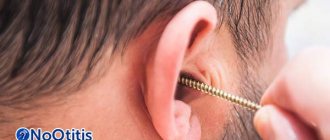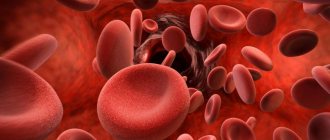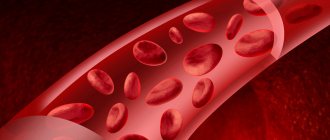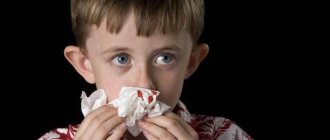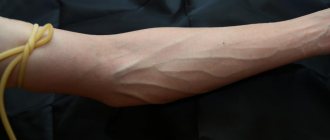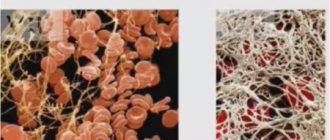After waking up, blood began to flow from the nasal passages. What is this symptom, and is it worth paying attention to? It never occurs to people who are far from medical knowledge that blood from the nose can signal serious problems in the body.
This is not a call to panic, because... This phenomenon also occurs during trifles, for example, a person picked his nose and damaged blood vessels. In order not to guess from the coffee grounds, especially when nosebleeds in the morning are systematic, you must definitely consult an otolaryngologist and therapist.
Features of the structure of the nose
The nose is one of the organs of the human body that performs the following functions: cleansing and recognizing odors.
The mucus lining the nasal passages protects normal microflora from bacteria and viruses.
If the immune system is normal, as a rule, the sores do not “stick” or go away quickly.
The nasal cavity has a bone and cartilaginous structure. The nasal turbinates form passages. Thanks to the lower passage, tears flow out of the eye.
The nasal cavity contains many small capillaries supplied by the ophthalmic artery. The densest capillary network is located in the Kisselbach zone, near the nasal septum (in the anterior third of its part). The largest percentage of all nosebleeds are found in this area.
Dried blood in the nose: reasons why it is baked in the morning and how to get rid of dried blood?
- Home
- Diseases
- Nose
- Causes and treatment of dried blood in the nose: is it dangerous?
Crusts in the nasal passages are a common occurrence with a cold. But why can dried blood constantly accumulate in the nose?
Why is it baked?
If you find dried blood in your nose, do not immediately panic. This phenomenon may be a consequence of completely natural reasons, for example:
- Dry air and dust in the environment. The nasal mucosa must be kept constantly moist. If the room is too dry and, especially, dusty, the mucus thickens and begins to form crusts. Such formations cause significant discomfort and force them to be picked off mechanically. As a result, the mucous membrane is injured and the crusts become bloody. But even without picking, capillaries can easily burst from drying out mucous membranes if they are not naturally strong.
- Dehydration of the body. With high body temperature, insufficient fluid intake and in the heat, the body loses moisture greatly. If its deficiency is not compensated, the mucous membranes will dry out and the capillaries in them may burst. The nose suffers first of all, since it is through it that all inhaled air passes.
- Injuries. Various mechanical damage to the nose and the mucous membrane itself in the nasal passages often lead to minor bleeding. They may be completely invisible from the outside, but cause bloody crusts to form inside the nostrils. This problem is especially common in children who are too fond of picking their noses.
Sometimes the formation of crusts from baked blood in the nose is still a symptom of malaise. In particular, such a violation can occur when:
- Atrophic rhinitis (ozene). This is a not well-studied disease, the main manifestations of which are crusts in the nose, as well as a foul odor from the nasal passages. These signs are explained by a chronic inflammatory process in the nose, which leads to atrophy of the mucous membranes. This disease is difficult to treat.
- Drug-induced rhinitis. This type of runny nose occurs with excessive use of vasoconstrictors. Its main symptom is chronic nasal congestion; a person loses the ability to breathe through the nose without the use of such medications. The constant use of vasoconstrictor drugs leads to disruption of the full activity of capillaries in the mucous membranes, which is why they can burst and bleed.
- Hormonal fluctuations. Sometimes the unexpressed fragility of the nasal capillaries, which leads to the formation of dried blood, is a consequence of hormonal fluctuations - during puberty, during pregnancy and menopause, as well as with various endocrine ailments.
Don't ignore dried blood in your nose. Even if such a symptom is caused by completely natural causes, in the absence of adequate correction it can be complicated by the addition of infection and other unpleasant health problems.
Causes of dried crusts in the morning
If bloody crusts in the nose appear only in the morning, most likely their appearance is associated with a dry environment. During the heating season, humidity in apartments drops to 30% or less.
If during daylight hours a person can compensate for such a negative impact by walking in the fresh air, consuming a sufficient amount of liquid, water procedures and wet cleaning, then during the night he has to constantly breathe too dry air. The capillaries cannot withstand this and burst.
The situation can be aggravated by regularly removing dried crusts, which will naturally be accompanied by even greater trauma to the mucous membranes.
Sometimes the cause of bloody crusts in the nose in the morning is also:
- Evening alcohol consumption.
- Insufficient drinking regime.
- Hot indoors.
- Lack of certain nutrients (hypovitaminosis).
If the blood dries up due to some serious health problems, this sign is usually noticeable during daylight hours. Although after a long sleep its severity may be greater.
How to treat?
When faced with the appearance of dried blood in the nose, the first step is to slightly change your usual lifestyle:
- Drink at least 1.5 liters of water per day, and more in hot and dry conditions. The liquid should be consumed in small portions, several times a day.
- Switch to a nutritious, balanced diet, give up alcohol and frankly unhealthy food.
- Ventilate the room thoroughly before going to bed, or even better - live with the window slightly open.
- Regularly carry out wet cleaning and get rid of all dust collectors. If possible, it is better to replace the bedding (pillow and blanket) with hypoallergenic ones - they will accumulate less dust and can be washed yourself.
- Get a humidifier and a hygrometer (a device for measuring environmental humidity). Hanging wet towels over radiators or using open containers with water, of course, also helps to humidify the air, but is not able to completely normalize the level of humidity and maintain it at the proper level.
As a rule, in most cases it turns out that the listed recommendations are quite enough to forget about dried blood in the nose forever. If, after a week of changes, crusts still continue to appear, then it’s time to go to an appointment with an ENT specialist.
Medications
The use of medications for the appearance of dried blood in the nose depends on the exact reason that caused such ailment. Among the drugs used may be:
- Saline solutions for rinsing the nose - Aquamaris, Humer, etc. Similar products are prescribed to all patients with such problems. They help cleanse the nasal passages, moisturize the mucous membranes and ensure optimal regeneration. Saline solutions can be used as drops or spray several times a day (without restrictions).
- Oils, for example, sea buckthorn or apricot. Such agents are used to treat mucous membranes in order to soften the crusts and facilitate their removal. In addition, oils help activate regeneration processes.
- Antibacterial drugs. Such drugs can be used to confirm atrophic rhinitis based on bacterial culture results (after identifying bacteria in nasal discharge and determining their sensitivity).
- Hormonal sprays (for example, Nasonex or Avamys). Such medications help cope with drug-induced rhinitis. They perfectly eliminate swelling and inflammation, and make it possible to “wean off” vasoconstrictor medications. Hormonal sprays are not absorbed into the systemic bloodstream, therefore they rarely cause side effects and are suitable for long-term use under medical supervision.
- Medicines that strengthen capillaries. For this purpose, doctors can prescribe taking Dicynone, Vikasol, Ascorutin, Rutin, calcium chloride and vitamin complexes (especially vitamins A, K and C).
Medicines should not be taken on your own initiative, as this can only harm your health. The only exception is the use of saline solutions.
Folk remedies
There are several quite effective traditional medicine methods that will help you quickly get rid of the problem of dried blood in the nose:
- Boil 1 liter of water, add 3-4 drops to it. essential oil of mint or eucalyptus. Breathe over the resulting steam for 10 minutes, covered with a warm towel. Repeat twice a day. After inhalation, beware of hypothermia.
- Brew 1 tbsp. l. chamomile, linden and mint 1 liter of boiling water. Leave the product for half an hour, then strain and use to rinse the nasopharynx twice a day.
- Take 2 tbsp. l. plantain herbs, brew 1 liter of boiling water and simmer over low heat for 10 minutes. Cool the finished medicine under the lid, then strain and use to rinse the nose.
- Before going to bed, drink warm water (1 glass) with juice from half a lemon and 1 tsp. honey This remedy will help strengthen the capillaries.
- Prepare equal parts of raisins, dried apricots, prunes, walnuts, lemon zest and honey. Grind all solid ingredients, add honey and mix. Eat 1 tbsp. l. 3 r. in a day.
Remember that any folk remedy can cause allergic reactions. For maximum effectiveness, it is worth combining alternative treatment methods with the use of medications prescribed by a doctor.
Source: https://elaxsir.ru/zabolevaniya/nosa/prichiny-i-lechenie-zasoxshej-krovi-v-nosu-opasno-li-eto.html
Local reasons
Vascular damage
The septum of the nasal cavity is lined with a network of small vessels (capillaries).
Their damage causes nosebleeds, including in the morning. Injuries of any nature (falls, blows), including nose picking, are the main culprits for violating the integrity of the capillaries.
During mechanical damage, blood vessels rupture. If one vessel is damaged, there is practically no bleeding as such. Blood appears, but literally disappears after a few seconds.
When several vessels are injured, bleeding can be severe, and in some cases even tamponade (anterior or posterior) is required.
Erosion of the vascular wall
Damage to blood vessels can be caused by prolonged inflammation in the nasal cavity.
Chronic diseases contribute to the destruction of capillaries, and, as a result, nosebleeds appear.
This lesion is associated with the structure of the vascular wall (it is very thin).
Another cause of erosion of capillaries and larger vessels is the long-term use of vasoconstrictor nasal medications. They corrode the already thin layer of epithelium of the nasal mucosa, resulting in erosions and then bleeding.
The eroded mucosa cannot withstand literally minor impacts, because... damaged vessels lose their strength. The diagnosis of “erosion” is made by an otolaryngologist after rhinoscopy.
Hemangioma is a benign tumor
Hemangiomas are a tumor-like formation (non-cancerous), which consists of a large collection of vessels.
This tumor likes to be localized in the nose. Normal vessels of the nasal mucosa are not dilated, but in hemangioma this is the main symptom.
When the hemangioma becomes dry and damaged, intense bleeding begins.
The tumor itself is not life-threatening, but severe bleeding leads to blood loss. Hemangioma must be differentiated from other, more dangerous, tumor-like neoplasms. For this purpose, a histological examination is carried out.
Angiofibroma of the skull is a benign tumor
Unlike hemangioma, angiofibroma, in addition to dilated vessels, also has connective tissue.
The growth of the tumor (its focus) is localized at the base of the skull.
When the tumor grows and reaches the nasal cavity, there is a possibility of frequent and heavy bleeding.
To confirm the diagnosis of angiofibroma, a tomographic examination of the head is performed.
Only histology can exclude the malignant nature of a tumor, but to conduct this study you will need to take a sample (a piece of tissue) from the neoplasm itself.
Reasons for appearance
In medical terminology, this phenomenon is called epistaxis (nosebleed). Its appearance may be preceded by:
any injuries; possible diseases of the nose or paranasal sinuses; blood diseases; long-term use of certain medications (or side effects of medications).
These problems do not always indicate that you have some kind of disease. There are situations when bleeding only means that you are tired and need to rest. Sometimes the cause is a long stay in frosty air - then the mucous membrane dries out, the vessels burst, the blood does not flow so abundantly and stops. This also includes sunstroke or heatstroke (prolonged exposure to the sun or in a very warm room).
High blood pressure very often causes bleeding.
Common reasons also include:
High blood pressure. A very common cause of a situation where blood flows from the nose. Small vessels of the nasal mucosa rupture under tension. The result is blood. It is worth pointing out that with high blood pressure it can last all day, not just in the morning. After treatment for problems with high blood pressure, a crust may remain on the nasopharyngeal mucosa. This is unsafe, you need to see a doctor immediately. Polyps. They originate in the sinuses and lead to nasal dysfunction, difficulty breathing and a lack of sense of smell. Bleeding from the nose often appears due to polyps. The growths interfere with breathing and physically irritate the nasal mucosa; surgical intervention is indispensable. Pheochromatocytoma. This is a disease that affects the adrenal glands. Why is there a problem? Because the stress hormone is released very intensely, which increases blood pressure, and the nose bleeds. By the way, this is one of the most important symptoms when diagnosing this disease. Cocaine. This drug, in addition to being toxic to the body, also has a number of symptoms of physical effects. Cocaine destroys the nasal mucosa, making it so thin that any touch provokes blood. Other. There are many reasons in this group: Overwork can cause a deficiency of vitamins, and this will make the mucous membrane so vulnerable that blood will appear from the slightest injury. Colds of the nasopharynx lead to the mucous membrane becoming swollen and inflamed. That is why blood flows, often with pus or other secretions. If, in addition to blood, other discharge appears, it means that the disease is progressing. This is a reason to immediately consult a doctor or at least change the nasal spray or drops. Bleeding can also be a consequence of poor blood clotting. In this case, any scratch will cause bleeding, the process is sometimes difficult to stop. Hormonal imbalances can also cause the appearance of blood. Their excess or deficiency can lead to increased pressure, which, in turn, leads to bleeding.
Neoplasms of a malignant nature
In the nasal cavity, a malignant tumor feeds on various substances. Such a tumor can consist of various tissues, both soft and hard. Malignant neoplasms have a large number of vessels.
Under the influence of cancer cells, the vascular wall becomes brittle, therefore, the risk of bleeding increases. The intensity of bleeding depends on the size and location of the tumor. Diagnosis is carried out using MRI or CT, as well as histological examination.
- Bleeding, in principle, should be alarming because it is not a normal condition;
- Nosebleeds during pregnancy - causes, treatment;
- - how to take blood from the nose.
Cocaine use
Using cocaine can also cause nosebleeds. This reason is more typical for younger people who lead an unhealthy and immoral lifestyle.
The thing is that this toxic substance has a very strong effect on the human body. First of all, it destroys the mucous membranes. That is why the mucous membrane of the nasopharynx also suffers. Due to such destructive processes in the future, any touch in the membrane can lead to new bleeding. In this case, dryness in the nose will be felt constantly, and not just after bleeding.
Common Causes of Morning Nosebleeds
Infections
Severe infectious processes such as influenza can cause bleeding from the nasal cavity.
Bacteria and viruses can “poison” the body by releasing toxic substances.
The latter affect the condition of the blood vessels, making them brittle, hence the tendency to blood from the nose.
It should be noted that severe viral infections affect the entire vascular bed in the body.
Hypertension
Increased pressure against the background of fragile blood vessels can provoke nosebleeds at any time, but this phenomenon is more often observed in the morning.
Patients also note headache, flushing of the face, sometimes fever or chills, and tinnitus.
In principle, the appearance of blood from the nose during hypertension can be considered a kind of protective reaction. People even say: “It’s good that the nose bled and there wasn’t a cerebral hemorrhage.”
Of course, these two phenomena are not related, but if bleeding occurs repeatedly, you should definitely adjust your blood pressure. Hypertension is fraught with strokes.
Also note that high blood pressure can be caused by pathologies such as pyelonephritis and glomerulonephritis. Some endocrine diseases cause persistent hypertension. Prolonged stress, anxiety and other mental disorders affect blood pressure.
Rondu-Osler syndrome
Few people have heard about this pathology. The disease is accompanied by repeated nosebleeds.
- Rondu-Osler syndrome is rare and is only inherited.
- Already at birth there is a defect in the structure of the vascular bed (vessels are very thin and fragile).
- Any minor exposure will result in nosebleeds.
Vasculitis
The name “vasculitis” unites a group of pathologies caused by immunopathological inflammatory processes in blood vessels (periarteritis nodosa, aortoarteritis, Charge-Strauss syndrome, others).
The immune system mistakes its own vessels for enemies and shows aggression towards them.
The strength of blood vessels decreases sharply, and, as a result, bleeding from the nasal cavity occurs. Histological examination of a tissue sample from the nose will help confirm or refute vasculitis.
Diseases of the hematopoietic system
The cause of frequent nosebleeds is a malfunction of the hematopoietic system.
The blood formula consists of various cells. For example, red blood cells, white blood cells, and platelets are formed in the bone marrow (this is a rather complex process).
If there are few red blood cells and low hemoglobin, the patient will suffer from anemia. When there is a lack of platelets, thrombocytopenia occurs. Very low or high white blood cells may indicate dangerous diseases (leukemia and myeloma).
To confirm any of the pathologies, a general blood test is performed, and, if necessary, the bone marrow is examined (a puncture of the chest is performed). With diseases of the hematopoietic organs, nosebleeds are not uncommon.
Liver diseases
The liver is a unique chemical laboratory of the body.
It is in it that the necessary chemical balance of all useful substances is maintained. Thanks to the well-coordinated work of the liver, the blood has the necessary clotting. With cirrhosis, hepatitis (of various etiologies), a blood clotting disorder is observed.
With a lack of clotting ability, nosebleeds occur. Other signs of pathology may also appear, such as hematomas.
A detailed diagnosis is required to make a diagnosis. Conduct general clinical and biochemical blood tests, ultrasound and other diagnostic procedures.
- However, there is no need to panic ahead of time;
- Stuffy nose - what to do, causes, treatment in children and adults;
- – brown snot.
Symptom options
Let's consider several variations of how this or that pathological process can manifest itself. Based on the symptoms, the doctor may suspect a certain disease.
Green snot with blood
If at first the nasal discharge was mucous and had a transparent color, and then acquired a green tint, then this is a clear sign of a bacterial infection. If the number of blood clots increases, then there is a suspicion of meningococcal infection. In this case, it is better to contact a specialist.
White snot with blood
May indicate injury. In addition, such a symptom can be provoked by: allergic rhinitis, adenoiditis, polyposis, sinusitis.
Yellow snot with blood
As a rule, this indicates the development of an acute inflammatory process in the upper respiratory tract or damage to the nasal mucosa. Prolonged rhinorrhea requires hospitalization, especially when it comes to children.
So, if you have a bloody nose, don't panic. Don’t overwhelm yourself with scary diagnoses. If the symptom occurs rarely and is preceded by an injury or cold, then in most cases there is no cause for concern. However, in some cases, the cause of this phenomenon may be serious somatic diseases. In order to exclude pathological etiology, it is better to consult a specialist for an accurate diagnosis and examination. Remember, prevention is better than cure. Already now, strengthen your immune system, avoid bad habits, monitor the temperature and humidity levels - all this will help prevent the appearance of blood in the nose.
What else can cause nosebleeds?
Sometimes the appearance of nosebleeds in the morning is spontaneous.
In full health, suddenly after sleep a person notices that a trickle of blood is flowing from the nasal passages.
This phenomenon may be associated with a sharp change in atmospheric pressure.
This usually happens when the climate changes, for example, you travel to a mountainous area or are in hot countries. Most often, it is in the mountains that repeated nosebleeds and symptoms of oxygen deprivation are observed.
In some cases, nosebleeds are detected with a sharp increase in body temperature (above 39 degrees). High body temperature accompanies many ailments, so here everything depends on the individual characteristics of the body. With heat and sunstroke, prolonged stay in a stuffy room, steam rooms, fever, bleeding from the nose, and even loss of consciousness are also often observed.
Blood from the nose, and not necessarily in the morning, can be caused by a foreign object. Of course, the lion's share of all cases falls on the children's population. Children, exploring the world, try to stuff all sorts of objects into their mouths and noses, sometimes not always of small caliber. Mechanical damage leads to trauma to the mucous membrane and bleeding.
Experts believe that the time factor for the appearance of nosebleeds is a kind of diagnostic clue. Some argue that nosebleeds with hypertension appear more often after lunch, although everything is individual.
Hypertensive patients may disagree, because... suffer from high blood pressure around the clock. In any case, if bleeding from the nose occurs frequently, you need to sound the alarm and consult a specialist.
Local causes of morning epistaxis
In the morning, nosebleeds most often occur after a person begins to do his toilet. Pressing on the nose when washing and performing other hygienic procedures can cause epistaxis.
There are local reasons why people suffer from this disorder. Let's look at them in more detail.
Getting injured. When the head and face are injured, the nose is the first to suffer, since it is the most fragile and most protruding part of the skull. When capillaries and vessels rupture and blood flows, this is a completely normal phenomenon. However, even the next day after the bruise and several days later, epistaxis may recur in the morning. This indicates that degenerative processes are occurring in the mucous membrane and you need to consult a doctor. Infectious lesions of the mucous membrane. Constant irritation, inflammation and swelling of the mucous membrane accompanies diseases such as sinusitis, rhinitis, adenoids and other infections. At this time, the capillaries become especially brittle, as the pressure inside them is increased. Therefore, when doing the morning toilet or blowing your nose, your nose bleeds. If the infection is completely eliminated, epistaxis will subside. Foreign body. The nose may bleed in the morning because a foreign body has entered the passages. Most often this happens in young children, but adults are also susceptible to this disorder. Epistaxis is caused by objects with sharp edges; they disrupt the integrity of the mucosa. If such a cause of bleeding is detected, you should immediately contact an otolaryngologist, who will remove the foreign particle from the nostrils. Neoplasms. Neoplasms such as polyps, synechiae and cysts can lead to the formation of blood in the nose, which flows out in the morning. They cause degenerative processes in the mucous membrane, making it thin, dry and hypersensitive to damage. The stream of blood in such disorders is thin, epistaxis does not last long and easily stops. To completely eliminate a violation, it is necessary to remove its cause.
First aid rules for nosebleeds
Let's first determine what actions should not be taken. Here is their list:
- There is no need to stuff cotton swabs into the nasal passages;
- do not try to remove a stuck foreign body yourself (the problem may worsen);
- throwing back the head when stopping the blood does not have an effect; on the contrary, the flowing blood enters the pharynx and then into the stomach, resulting in a gag reflex;
- In case of nasal injuries, nothing can be adjusted on your own. The patient needs to be taken to oral and maxillofacial surgery.
Nosebleeds in the morning
The next reason that causes frequent nosebleeds is the appearance and growth of polyps, which can also be located in the nasal cavity. Polyps are the result of processes during which the mucous membrane inside the nose begins to grow. This also blocks its normal functioning.
Such polyp-like growths prevent a person from breathing and also create pressure in the vessels of the nasal cavity. With this phenomenon, blood fluid comes out quite often, this is especially true in the morning. The nose also feels dry. Very often the patient feels the urge to put his fingers into his nose to scratch it, remove the annoying crust, or, even worse, pull out a polyp.
This absolutely cannot be done on your own. Such actions lead to a second attack of bleeding, which will be no weaker than the previous one. Only an experienced surgeon can cut out polyps. Surgical intervention in this case is the most effective method of eliminating the polyp, but it is necessary to understand the reasons that cause disturbances in the functioning of the nasopharyngeal mucosa.
Nosebleeds can be caused by stressful situations that increase blood pressure. In addition, any injury to the nose results in damage to the blood vessels in it. Inflammatory processes in the nose, colds, and infectious diseases in the nasopharynx can provoke bleeding. If a person is overheated, then this may also be the reason.
The regular occurrence of a phenomenon such as nosebleeds (epistaxis) should cause concern in a person. Bloody nose in the morning, which appears constantly or periodically, is one of the symptoms of a serious illness. If such a deviation occurs, it is imperative to undergo a medical examination in order to identify and eliminate the provocateur.
| Type of reason | What provokes it? |
| System | Vascular diseases |
| Emphysema | |
| Whooping cough | |
| Hormonal disbalance | |
| Allergy | |
| Measles | |
| High blood pressure | |
| Cold | |
| Scarlet fever | |
| Avitaminosis | |
| Blood diseases | |
| Alcohol abuse | |
| Side effects of certain medications | |
| Local | Nose injury |
| Inflammatory processes | |
| Inhalation of illegal substances (substance abuse and drug addiction) | |
| Using medications that dry out the nasal mucosa | |
| Use of steroid sprays | |
| Barotrauma | |
| Tumors | |
| Dry air |
It often happens that a person wakes up due to a nosebleed. This is not a very pleasant syndrome, but it can happen to anyone. It can happen during morning sleep, breakfast, or when a person has already started his morning activities. After the blood flows, discomfort is felt, the mucous membranes become dry, and the skin seems to tighten.
To prevent problems from happening again, you need to know the reason and how to act if such a situation occurs. All symptoms may be the same, despite differences in causes. Before going to the doctor, you need to remember at what time the bleeding begins, as well as for how long it has been ongoing.
This way you can find out why your nose bleeds in the morning.
There are several common causes of bleeding, which include:
- high blood pressure;
- polyps in the nasal cavity;
- pheochromaticoma;
- cocaine use;
- stress;
- injuries
It is necessary to consider each of the reasons separately.
Pressure surges
The most common factor that causes bleeding when blowing your nose in the morning is high blood pressure. Problems with blood pressure can occur not only in people of retirement age. At the same time, as blood pressure rises, the pressure of blood in the vessels also increases.
https://www.youtube.com/watch?v=yN0iDmMKm44
If the vessels are weak, thin, fragile, and cannot withstand heavy loads, they can burst and blood will flow. If your blood pressure is elevated, you should seek help from a doctor as soon as possible - they will prescribe special medications.
Along with taking medications, you also need to strengthen the blood vessels so that they do not react to every increase in pressure.
If the reason is that the pressure constantly fluctuates, bleeding may occur not only in the morning, but also at night and during the day. It is necessary to take special medications to normalize blood pressure.
Blood pressure pills will help control the bleeding, but the nasal cavity will most likely become dry. If the mucous membrane becomes too dry, a crust may form.
If blood from the nose flows in the morning due to hypertension, then it will flow slowly and the stream will be small.
An equally common cause of bleeding is the growth of polyps in the nasal cavity. Polyps are the result of the process of proliferation of the mucous membrane.
Because of this, the mucous membrane ceases its normal functions. Polyps cause difficulty breathing, as well as pressure in the nasal vessels.
If polyps occur, morning bleeding can occur quite often, and the nose also becomes unpleasantly dry.
Also, in this case, the patient really wants to scratch his nose from the inside, to remove the crust that is in the way, but under no circumstances should this be done.
If you do this, the bleeding will recur, and it may be even worse than the previous one. If you have problematic polyps, you need to see a surgeon who can cut them out.
Contacting a surgeon will be very effective, but before that you definitely need to figure out why exactly the blood is flowing.
Pheochromocytoma
Pheochromacytoma is a tumor of the adrenal glands. Such a tumor affects hormones, which in turn cause bleeding, since a lot of stress hormone is released into the blood. Because of this, the pressure increases and sometimes blood flows from the nose.
The disease, although rare, causes blood to flow. You need to see a doctor as soon as possible, undergo examinations and begin treatment, following the doctor’s advice. The remedies will help get rid of both the tumor and normalize blood pressure.
It must be remembered that it is the dry nasal cavity and the flow of blood from it that can become the main signs of detecting an adrenal tumor. Therefore, you cannot ignore the problem; you need to undergo an examination.
A nosebleed in the morning can also be due to problems with cocaine. The problem for this reason usually occurs among young people who lead an unhealthy lifestyle.
Cocaine has a significant negative impact on the health of the body. Since it is consumed through the nasal cavity, it actively destroys the mucous membranes, especially affecting the nasopharynx. Due to these breakdown processes, any irritation of the nasal membrane can cause bleeding. If the problem is due to cocaine use, dry mucous membranes will be a constant feature.
Bleeding can also be due to stress, which contributes to increased pressure, which in turn affects the blood vessels.
Any injury to the nose also causes bleeding. No matter what it is, the blood vessels are severely damaged and blood may flow continuously. Overheating, infections, colds and inflammation in the nasal cavity are all causes of bleeding in the morning and more.
Only a tenth of all nosebleeds are due to serious health problems. In other cases, everything is fixable, but you must definitely seek help from a doctor and get examined.
There are several ways to help stop the flow of blood. Typically, sick people pinch their nose with their fingers for a few minutes. This action helps the blood clot and stop flowing. The wounds become covered with a blood crust, so the flow stops.
Don't tilt your head back. This will not only not help solve the problem, but will also worsen the situation. In this case, the liquid will first go into the pharynx and then into the intestines.
You can use special solutions in which cotton swabs are soaked to stop bleeding. They need to be placed in the sinuses.
If nothing helps, you need to see a doctor, he will help you cope with the problem using drastic methods, such as cauterization of blood vessels, cutting out polyps, or nasal tamponade. Only a professional can perform such procedures.
It is clear that it is best to carry out prevention rather than treat the disease. Under no circumstances should you put your fingers in your nose. If the mucous membrane is too dry, it can be moisturized using a special gel based on Vaseline and a salt solution. You also need to humidify the air and drink plenty of fluids.
If you pay attention to yourself and your health, you can cope with any problem. Bleeding may soon stop bothering you.
If you notice that your nose bleeds periodically in the morning, you should not put off visiting the clinic. Until the cause of this phenomenon is established, there is no point in panicking. No more than 10% of this anomaly indicates a serious illness.
A nosebleed in the morning can occur for various reasons.
excessive stress caused by physical and emotional factors; exposure to dry air flow in apartments in winter or prolonged exposure to low temperatures; brain dysfunction after prolonged exposure to the sun; mechanical damage resulting in injury; rhinitis;
In the morning, nosebleeds may occur due to inflammation of the paranasal sinuses; with increased blood pressure; each of us has used a spray for a runny nose, and it can cause irritation of the mucous membrane; tumor processes within this organ; inserting objects into the nose (babies often sin with this); inhalation of drugs;
surgical interventions; liver pathologies; alcohol abuse; diseases of the hematopoietic system; lack of vitamins C and K in the body; cardiovascular failure; sudden changes in atmospheric pressure; hormonal disorders during pregnancy; polyps;
Bleeding may be caused by decreased blood clotting or exposure to blood thinners.
Often the reason why the nose bleeds in the morning is a deviated septum due to injury. And also the reasons that blood flows in the morning can be: smoking, harmful working conditions, vascular atrophy due to overwork, strong nose blowing.
How to stop nosebleeds on your own?
Let's make a sequential list (algorithm) of actions when providing first aid:
- ask the patient to lower his head forward;
- Cold should be applied to the bridge of the nose (a piece of ice, another cold object or product). Place cold objects only through thick fabric so as not to damage the skin;
- Insert a gauze turunda into the nasal passage, from where the blood flows;
- for the best effect, turundas are moistened in vasoconstrictor solutions (any vasoconstrictor nasal drops will do);
- In case of intense bleeding, before the doctor arrives, replace the gauze swabs.
Medicines to stop nosebleeds
If the bleeding is heavy and frequently recurring, there is a reason to contact a hematologist who will prescribe treatment and a list of medications.
They can be used to reduce blood loss. The list includes the following drugs:
- Hemostatic tube - the use of the drug is recommended to stop severe bleeding (from the gums or nose). The composition includes: blood plasma of cattle or humans, calcium chloride and thromboplastin. Together, these components can have a hemostatic effect. A hemostatic tube is used, observing the following sterile conditions: it is necessary to dry the nasal cavity with a gauze swab in advance and place a piece of sponge inside. After 24 hours, remove the formed fibrin film. The remaining sponge particles will resolve within a month.
- Aminocaproic acid is a drug of general and local action. The release form is a translucent white powder that dissolves well in water. Without taste and smell. The drug stops bleeding, reduces fibrinolytic activity and is used for heavy blood loss.
- Dition (etamsylate) – available in the form of tablets (0.25 mg) and ampoules (2 ml). Prescribed by a doctor to eliminate capillary bleeding. Also used for prevention. The drug improves the function of platelet activity and reduces capillary permeability.
- Contrical is a powder for preparing a solution for intravenous administration. Prescribed for profuse nosebleeds, mainly caused by injuries. The drug reduces the risk of blood clots.
- Rutin (vitamin P) is a general strengthening drug, the action of which prevents capillary fragility. Available in single-component preparations and as part of Ascorutin tablets (in combination with ascorbic acid).
- Thrombin is a potent drug that is taken under the supervision of a physician. Capable of stopping bleeding in a short time. Used for various types of bleeding. The drug is available in the form of a loose mass of light pink color, diluted with saline solution. Used in the form of lotions or tampons moistened with a solution to stop bleeding.
Medical assistance – when is it required?
Let's decide when medical help is needed:
- intense bleeding (you can’t stop the bleeding on your own);
- blood flows profusely with clots;
- the patient loses consciousness;
- the appearance of cold sweat and severe weakness;
- stuck foreign body.
Any object that gets into the nose can only be removed by an otolaryngologist using a special hook. After removing the foreign object, the doctor uses hemostatic agents to stop the bleeding. Then the damaged area will be treated with antiseptic solutions.
Difficult-to-stop bleeding is eliminated with anterior tamponade (using a bandage, a dilating device and tweezers). Tamponade is performed only after anesthesia.
When there is no effect after anterior tamponade, posterior tamponade is performed (a tampon is placed behind the palatine curtain). The second procedure is technically more difficult and is performed only after anesthesia. If both tamponades (anterior and posterior) do not help, resort to ligation of the external carotid artery.
The otolaryngologist is often able to determine the affected source from which blood is released. In such cases, they resort to the cauterization method (using a laser, liquid nitrogen, or an electrocoagulator).
Methods for treating nosebleeds
There are various ways to stop nosebleeds in the morning. If this is an isolated phenomenon, then it is quite possible to do it on your own. But, if the situation repeats regularly, there is a real reason to consult a doctor. It is the specialist who will be able to accurately determine the cause of the bleeding and select effective treatment.
Medication methods
In cases where bleeding is profuse and difficult to stop, it is necessary to resort to hemostatic drugs. The effect is achieved by increasing blood clotting. Examples of such medicines may be:
- Dition;
- Vikasol;
- Aminocaproic acid;
- Adroxon.
Dition is a drug for treating nosebleeds in the morning.
Among the homeopathic medicines that are used in this case, the following should be highlighted:
- Acidum;
- Witch hazel;
- Aconite.
Calcium supplements can also be used to stop bleeding.
A patient with frequent cases of nosebleeds, depending on the diagnosis, may be prescribed various additional medications, for example, those that reduce high blood pressure.
In addition to drug treatment, the patient may require special procedures. This:
- Physiotherapy;
- Nasal tamponade, both anterior and posterior;
- Laser coagulation;
- Electrocoagulation.
You cannot prescribe such procedures for yourself, as they are serious in nature, and some of them relate to surgical interventions.
Traditional methods
If your nose bleeds in the morning, you can turn to traditional medicine for help. The following methods can resolve the problem:
- Calamus ointment. To make it, 1 teaspoon of finely ground plant root is added to 50 milliliters of ordinary Vaseline. The components are thoroughly mixed together. The prepared ointment is applied to the nasal mucosa up to three times a day;
- Nettle juice. Cotton swabs should be moistened with the juice of this plant and then inserted into the nasal passages;
- Yarrow. You will need the leaves of the plant. They must be thoroughly ground so that they yield juice. It should be instilled into a clean nose.
Traditional medicine recipes have been successfully used for many centuries. But, despite their wide popularity, it is important to remember that the main therapy is still medication.
Prevention
Preventive measures to prevent nosebleeds include:
- treatment of chronic foci of infection in the body;
- competent treatment of acute infectious diseases;
- normalization of blood pressure;
- control cholesterol levels;
- annual medical examinations, including general and biochemical blood tests;
- correction of hormonal imbalances;
- on hot days, you should protect yourself from direct sunlight and increase your water consumption;
- Before traveling to other climate zones, visit a therapist and find out if you can change the climate.
Dried blood in the nose: causes
The main reason why blood is baked in the nose is a disruption in the proper functioning of the smallest vessels of the mucous membrane lining the inner surface of the nasal cavity. As a result, the capillaries burst and a small amount of blood flows out.
Since its amount is tiny, bleeding as such is usually not observed. But the mucus secreted by each person turns red, which gradually changes to brown, dark brown or black.
This can be seen in the background:
- excessive dry air in the home or office, which is usually characteristic of the heating season and summer;
- inhalation of certain compounds that can cause an allergic reaction and irritation of the mucous membrane;
- use of vasoconstrictor drops or sprays, especially for a long time;
- sinusitis, chronic atrophic rhinitis, the presence of neoplasms (polyps, cysts, tumors, etc.);
- diseases of the endocrine and cardiovascular system, in particular hypertension;
- disruptions in the functioning of the immune system, which is typical for vasculitis and some other systemic pathologies.
However, most often the nasal mucosa bleeds under the influence of mechanical irritants. This is most common among children, who find nose picking extremely entertaining.
Baked blood in the nose and dryness are a common occurrence in pregnant women, especially in the first trimester. This occurs both due to the reduced humidity of the inhaled air, and against the background of physiological changes accompanied by an increase in progesterone levels.
During this period of a woman’s life, there is an increase in the volume of blood circulating in the body, although the indicators of vascular elasticity remain the same.
As a result of this, their walls expand and blood pressure increases, which is what causes nosebleeds.
Causes of nosebleeds in children
At appointments with pediatricians, the question is sometimes asked: “In the morning, after sleep, the child’s nose began to bleed, is there any reason for concern?”
There is no doubt that the doctor will definitely draw up an examination plan and the cause will be found. The causes of nosebleeds in children are:
- hereditary pathologies;
- nasal injuries;
- foreign bodies;
- bacterial and viral infections;
- hormonal imbalance;
- long-term use of nasal vasoconstrictors;
- overvoltage;
- anatomical pathologies;
- chemical, thermal and radiation exposure;
- neoplasms.
The nasal passages in children are narrow.
Considering the abundant blood supply and the entire child’s physiology, you need to understand that the slightest external influence can lead to nosebleeds. As in adults, nosebleeds can result from various pathologies.
Parents must take their child to the doctor. You shouldn’t remain in the dark for months and wait for everything to resolve itself. Vitamin C is often used in pediatrics; it is responsible not only for immunity, but also for the vascular health of young patients.
Nosebleeds in the morning: methods of prevention and treatment
Additional education:
“Hematology”
Russian Medical Academy of Postgraduate Education
Contacts
What to do if the morning often begins with nosebleeds? This unpleasant syndrome, called epistaxis in medicine, may indicate serious health problems, or may have easily removable causes. The main thing is not to panic, but to try to figure them out together with your doctor.
Why does my nose bleed?
If the nasal mucosa is healthy, blood may appear as a result of microtrauma during the morning toilet. For example, as a result of vigorous blowing of the nose, a small vessel burst and minor bleeding occurred. But if your nose bleeds frequently in the morning, this is a reason to visit an otolaryngologist. The most common causes of nosebleeds:
- low air humidity in the sleeping area, resulting in drying of the nasal mucosa;
- constant use of sprays and drops for the common cold;
- frequent rhinitis and sinusitis;
- adenoids or polyps.
These are local “nasal” problems that are successfully treated by an ENT doctor. Constant dryness or the effect of local medications for the common cold leads to degenerative processes in the nasal mucosa, in particular to the thinning and fragility of its blood vessels.
More serious causes are diseases of the lungs, blood vessels, heart and kidneys:
- A nosebleed in the morning is a symptom of arterial hypertension. When blood pressure rises, the pressure on the walls of blood vessels, including small ones, increases sharply. They can't stand it and burst. This bleeding often brings relief to the patient, acting like natural bloodletting. Epistaxis in hypertensive patients occurs not only in the morning, but at those moments when the pressure “jumps.”
- Nosebleeds can be triggered by negative processes in heart failure, atherosclerosis, and increased intracranial pressure as a result of a sharp rise.
- Another serious cause is a tumor in the adrenal gland called pheochromacytoma. Moreover, this symptom – blood from the nose – plays an important role in diagnosing the disease. The tumor causes a hormonal imbalance. The adrenal glands begin to produce large amounts of stress hormone, causing an increase in blood pressure.
- In the presence of cancer, blood flows from the nose due to tumor growth or metastases.
- Nosebleeds are common when taking aspirin or other drugs that reduce blood clotting. Also, this syndrome can appear with low levels of vitamins C and P in the body, which affect the condition of the vascular walls.
- Overwork or stress, causing a one-time rise in blood pressure.
Recurrent bleeding may indicate a systemic bleeding disorder.
What types of bleeding are there?
The most common and at the same time less dangerous is anterior bleeding. The anterior section of the nasal cavity is densely permeated with vessels, but they are small, so bleeding is not profuse.
Usually it is stopped in simple ways or it stops on its own. However, with frequent bleeding, blood loss “accumulates,” which leads to chronic fatigue and weakness characteristic of anemia.
The hemoglobin level decreases, and other symptoms of anemia appear.
Posterior bleeding is more dangerous and can threaten health and even life. They are much more difficult to cope with, they are more abundant and last longer. Usually, to stop the bleeding you have to resort to medical help.
In the case of posterior bleeding, the blood may not flow out of the nose, but go directly into the esophagus or trachea. Nausea, bloody vomiting, and expectoration of blood gradually appear.
With large blood loss, symptoms of anemia increase, and hemorrhagic shock may develop, which is expressed by:
- very rapid heartbeat;
- ringing in the ears;
- strong thirst;
- dizziness;
- increasing shortness of breath.
Such epistaxis is typical for elderly people with hypertension and atherosclerosis.
How to help with nosebleeds?
If the nosebleed in the morning does not stop on its own, you need to take action. Medical assistance will be required in the following cases:
- the day before there was an injury to the skull or nose;
- the blood flows strongly and cannot be stopped;
- large blood loss (more than 300 ml);
- during an exacerbation of kidney disease or cirrhosis of the liver;
- severe weakness, vomiting and general deterioration of the condition.
Children should not be left unaided during a severe viral infection accompanied by fever and nosebleeds. Basic measures to stop bleeding:
What to do? How to do it? Goal
| Calm the patient and sit him down correctly | The patient should sit (he cannot be laid down, otherwise blood will flow into the esophagus), tilting his head forward. If blood flows profusely, it is better to place a container under it | reduce anxiety that causes high blood pressure; |
| the container into which the blood will drain will allow you to see the amount of blood loss | ||
| Mechanical control of bleeding | Lightly pinch the nostrils with your fingers or insert small cotton swabs soaked in 3% hydrogen peroxide into the anterior nasal cavity. | Bleeding vessels are compressed and clots begin to form on them, blocking the place of blood flow |
| Cold | If you have ice, wrap it in a soft cloth and apply it to the bridge of your nose and the back of your neck. You can simply put your hands in cold water. | Under the influence of cold, the nasal vessels narrow and the severity of bleeding decreases. |
In case of nosebleeds, it is prohibited:
- throw your head back;
- blow your nose;
- independently remove a foreign body from the nose that causes bleeding.
Repeated morning nosebleeds should not be ignored. You need to see a doctor and eliminate their cause.
Source: https://CardioPlanet.ru/zabolevaniya/krov/krov-iz-nosa-po-utram-vozmozhnye-prichiny-i-neobhodimye-mery
My child often bleeds from the nose, which doctor should I contact?
If your child often has nosebleeds, you can go to an appointment with an ENT specialist. This will help determine how the vessels in the nose are located and perhaps the doctor will refer you for additional examination. In addition, you can contact your local physician at your place of residence. It is recommended to check your blood pressure readings with a neurologist; in addition, he will check the general condition of the blood vessels. Often the cause of frequent nosebleeds in a child is high blood pressure.
If you have nosebleeds accompanied by additional bruising, you should seek help from a hematologist. He is obliged to understand all the conditions of the blood itself.
Increased pressure
This factor is not the only one, but the most common. Most often, the pressure increases in older people, which is why their nose bleeds. However, such discomfort is possible not only in older people.
When blood pressure increases, the pressure of blood in the blood vessels increases. If the vessels are very fragile and thin, then they can burst from strong pressure. This is why capillaries burst in the nose. It is better to consult a doctor and carry out a comprehensive diagnosis, and then treatment. In addition, it is necessary to strengthen blood vessels.
If the cause is precisely fluctuations in blood pressure, then nosebleeds will be observed not only in the morning. This can happen at any time of the day. It is very important to take pills that can normalize blood pressure. Medicines that lower blood pressure can treat the cause of the bleeding. But then only dryness in the nasal cavity may occur. In some cases, due to excessive drying, the mucous membrane begins to become covered with a hard layer, similar to a crust. If the patient's nosebleed is caused by hypertension, then the blood will flow in a slow and small stream.
Cause: pheochromacytoma
Pheochromacytoma is a tumor formation in the adrenal glands. This phenomenon affects hormonal levels. It can provoke excessive releases of stress hormones into the blood. And this, in turn, can sharply increase blood pressure, which leads to nosebleeds.
This disease is considered quite rare, but it can also cause nosebleeds, and quite often. In this case, it is necessary to consult a doctor as soon as possible, as he will be able to diagnose and choose the most appropriate methods that will help cure this rare disease, as well as control blood pressure and hormonal levels. In addition, he will be able to advise what needs to be done to prevent bleeding from the nose so often. By the way, dryness in the nose and bleeding in this area are one of the important symptoms by which the presence of pheochromacytoma is determined during the diagnostic process.
Bleeding from the nose in a child
Often, if it occurs, the cause may be the Kisselbach point, i.e., the concentration of blood vessels located in the anterior portion of the nasal septum. Due to simple damage to the mucous membrane (for example, due to injury, finger picking, insertion of a foreign body), a child's nose may bleed. The condition can be accompanied by high fever, runny nose and sinusitis (in this case, hyperemia of the mucous membrane is observed).
Parents whose children are prone to nosebleeds should remember to prohibit giving them salicylates as antipyretics (Aspirin). These drugs reduce blood clotting and may themselves cause nosebleeds.
When it comes to first aid, never place a child (or adult) flat on their back. Firstly, it facilitates blood flow into damaged vessels and increases bleeding. Secondly, the patient suffocates with blood that flows down his throat.
A person should sit, or even better, stand. You need to hold the child's nose with a wet cold cloth for 2-3 minutes. The pressure exerted by the index finger and thumb should be very strong, despite the baby’s protests. Sometimes this procedure needs to be repeated several times.
But in any case, repeated morning bleeding from the nasal passages in a child is an indication that you need to go to the doctor. As a rule, he prescribes blood clotting tests and a consultation with an otolaryngologist. Kisselbach's point is often cauterized using trichloroacetic acid or silver nitrate. In rare cases, a minor surgical procedure is required (detachment of the mucous membrane or removal of part of it).
It's hard to find people who haven't had nosebleeds. The reasons can be both harmless damage to the vessels of the nasal mucosa and quite serious diseases. Changes that lead to bleeding can occur both in the nasal cavity and in other parts of the body. If you experience frequent bleeding, you need to go to the hospital, where you will be given a full examination and effective treatment will be prescribed.
Other reasons
During adolescence, children experience hormonal changes in their bodies . Therefore, from time to time, nosebleeds may occur, which disappear with the stabilization of hormonal levels.
In older people, crusts in the nose may occur due to age-related changes associated with degeneration of the mucous membranes.
Dried blood in the nose in the morning may indicate excessive physical activity the day before and lack of rest at night.
With severe overwork, sudden jumps in blood pressure are possible, which provoke nosebleeds.
Causes of bleeding
Not everyone knows why an adult’s (and even a child’s) nose bleeds in the morning. The most common causes of this condition are local bruises and drying of the mucous membrane. Less commonly, serious illnesses such as bleeding disorders or cancer.
Nosebleeds can range in severity from a dribble to a serious hemorrhage. The majority (80-90%) of the latter originate from the choroid plexuses of the anterior inferior part of the nose, since these areas of the mucous membrane are very richly vascularized and, in addition, thin and sensitive to bruises. This type of bleeding is mild and can be stopped by squeezing both sides of the nose for 10 minutes or by placing a cotton swab into the nasal openings.
Less common, but more serious, are bleeding that originates in the posterior part of the septum, located above the Lemeshev bone or to the side of the auricle. This type of hemorrhage can be difficult to stop and often requires the patient to be hospitalized.
When there is bleeding from the nasal passages in the morning, the reasons for this condition may be the following:
- arterial hypertension;
- infectious diseases that occur with high fever;
- hemophilia, thrombocytopenia;
- curvature of the nasal septum, bruise of the nasal area;
- atherosclerosis (especially in adult patients);
- a number of other diseases (tumors, inflammatory processes of the mucous membrane, foreign bodies, etc.).
Separation of reasons
There are external causes, i.e. bleeding from the nasal passages can be caused by external injuries to the nose or head, especially in young children. Also, flying and diving, which are associated with changes in atmospheric pressure, affect the appearance of this condition.
Local causes of nasal hemorrhage in the morning:
- dry runny nose caused by chemical and thermal damage;
- excessive use of drugs that dry the mucous membrane;
- dry air;
- cancer developing in the nose and paranasal sinuses;
- inflammation of the mucous membrane of bacterial and viral etiology;
- polyps;
- fibrosis of the mucous membrane.
Common causes of bleeding from the nasal passages upon waking:
- diseases of the cardiovascular system: atherosclerosis, arterial hypertension, which occurs mainly in older people;
- infectious pathologies, including influenza and measles;
- kidney and liver diseases (cause an increase in blood pressure, changes in the vascular wall);
- pregnancy;
- taking certain blood thinners, such as aspirin;
- diabetes;
- blood clotting disorders (vitamin K deficiency);
- lack of vitamin C - destroys the walls of small blood vessels;
- nosebleeds also occur during menstruation.
If your nose bleeds, you need to determine the cause. When nosebleeds occur frequently, you should consult an otolaryngologist. The doctor will have a conversation with the patient, during which he will find out:
- how often does the nasal passages bleed?
- patient's age;
- general state;
- in what situations does nosebleed appear?
- Do you have any chronic diseases?
- what medications the patient is taking.
After receiving the information, the doctor begins a laryngological examination, during which he can assess what the nose looks like (important, for example, after an injury). The specialist uses a Hartmann viewing glass to examine the nasal cavity, and the so-called viewing window helps to get to its deepest areas.
In addition to the classic examination, an examination of the pharynx is performed using flat mirrors. During this procedure, the doctor examines the mouth of the nasal cavity. Another type of diagnosis is a manual examination, during which the doctor uses his index finger to assess the presence of nodules in the patient. If they are present, the patient is sent for a visual examination for further diagnosis, most often a computed tomography or magnetic resonance scan.
If, after all the research and examination by the doctor, no nasal pathological changes occur, the patient is sent for a consultation with a therapist to find other causes.

